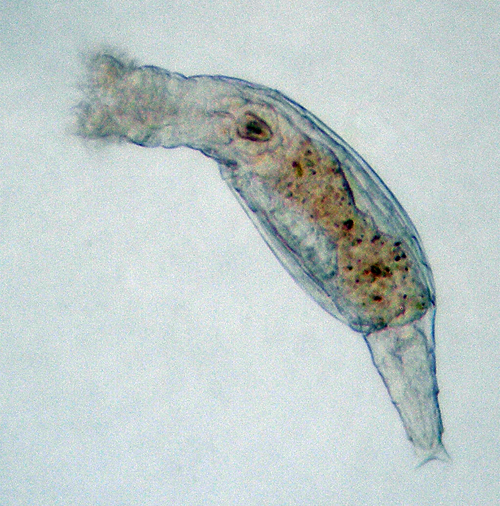Frozen for 24,000 years, this little creature has 'come back to life'

The last time this little creature had "opened its eyes" was 24,000 years ago. Back then, woolly mammoths still roamed the plains of Siberia. More than ever, like the tardigrades, rotifers present themselves as some of the toughest organisms on the planet.
Bdelloid rotifers are microscopic organisms generally invisible to the naked eye characterized by a distinct three-part morphology (mouth, trunk and foot) and often crawling locomotion. You will find them mainly in fresh water and in moist soil.
These creatures are some of the toughest multicellular organisms on the planet. Radiation, extreme acidity, starvation, low oxygen or dehydration, like the tardigrades, these little creatures can suffer many disappointments. Another recent discovery: bdelloids can also spring back to life after tens of thousands of years of freezing, according to a study published Monday in the journal Current Biology
Back from the dead
As part of this work, researchers from Russia's Soil Cryology Laboratory collected permafrost samples by drilling nearly 3.5m below the ground in the Alazeya River in northern Siberia.

In these 24,000-year-old samples (according to radiocarbon dating), they found bdelloid rotifers still alive in a state of cryptobiosis (the body “pauses” all biological functions).
First surprise: one of these organisms was then successfully “awakened” in the laboratory. And second surprise: this little creature didn't just live again, it also reproduced (asexual reproduction), suggesting that there is a mechanism by which multicellular animals can avoid damaging cells during the process of freezing and waking up as if nothing had happened.
“ We have resurrected an animal that in its day frequented woolly mammoths. It's really impressive , “said Stas Malavin, co-author of the study. " Our report is the strongest evidence yet that multicellular animals could withstand tens of thousands of years in cryptobiosis ."
Pour rappel, en 2016, un groupe de scientifiques japonais avait également réussi à faire revivre un autre animal résilient, le tardigrade, après trente ans de cryptobiose. Et jusqu’aux résultats de ces nouveaux travaux, des recherches antérieures sur les rotifères suggéraient que ces derniers pouvaient survivre à des gels profonds jusqu’à une décennie.
Ces organismes très impressionnants n’en restent pas moins déconcertants pour les chercheurs. On ignore en effet comment ils sont capables de protéger leurs cellules et leurs organes de conditions qui tueraient en quelques minutes n’importe quel autre organisme multicellulaire. Déverrouiller ces stratégies biologiques pourrait nous aider un jour à préserver nos propres cellules, tissus et organes, ici sur Terre et au-delà.
https://sciencepost.fr/cette-petite-creature-a-survecu-24-000-ans-gelee-en-siberie/?fbclid=IwAR2Jn73AsjpwjXo5Bm6t6ZXOymrN1nhir5o8yiS2AZVWWe1-gPr6LiFVOtQ

The last time this little creature had "opened its eyes" was 24,000 years ago. Back then, woolly mammoths still roamed the plains of Siberia. More than ever, like the tardigrades, rotifers present themselves as some of the toughest organisms on the planet.
Bdelloid rotifers are microscopic organisms generally invisible to the naked eye characterized by a distinct three-part morphology (mouth, trunk and foot) and often crawling locomotion. You will find them mainly in fresh water and in moist soil.
These creatures are some of the toughest multicellular organisms on the planet. Radiation, extreme acidity, starvation, low oxygen or dehydration, like the tardigrades, these little creatures can suffer many disappointments. Another recent discovery: bdelloids can also spring back to life after tens of thousands of years of freezing, according to a study published Monday in the journal Current Biology
Back from the dead
As part of this work, researchers from Russia's Soil Cryology Laboratory collected permafrost samples by drilling nearly 3.5m below the ground in the Alazeya River in northern Siberia.

In these 24,000-year-old samples (according to radiocarbon dating), they found bdelloid rotifers still alive in a state of cryptobiosis (the body “pauses” all biological functions).
First surprise: one of these organisms was then successfully “awakened” in the laboratory. And second surprise: this little creature didn't just live again, it also reproduced (asexual reproduction), suggesting that there is a mechanism by which multicellular animals can avoid damaging cells during the process of freezing and waking up as if nothing had happened.
“ We have resurrected an animal that in its day frequented woolly mammoths. It's really impressive , “said Stas Malavin, co-author of the study. " Our report is the strongest evidence yet that multicellular animals could withstand tens of thousands of years in cryptobiosis ."
Pour rappel, en 2016, un groupe de scientifiques japonais avait également réussi à faire revivre un autre animal résilient, le tardigrade, après trente ans de cryptobiose. Et jusqu’aux résultats de ces nouveaux travaux, des recherches antérieures sur les rotifères suggéraient que ces derniers pouvaient survivre à des gels profonds jusqu’à une décennie.
Ces organismes très impressionnants n’en restent pas moins déconcertants pour les chercheurs. On ignore en effet comment ils sont capables de protéger leurs cellules et leurs organes de conditions qui tueraient en quelques minutes n’importe quel autre organisme multicellulaire. Déverrouiller ces stratégies biologiques pourrait nous aider un jour à préserver nos propres cellules, tissus et organes, ici sur Terre et au-delà.
https://sciencepost.fr/cette-petite-creature-a-survecu-24-000-ans-gelee-en-siberie/?fbclid=IwAR2Jn73AsjpwjXo5Bm6t6ZXOymrN1nhir5o8yiS2AZVWWe1-gPr6LiFVOtQ

